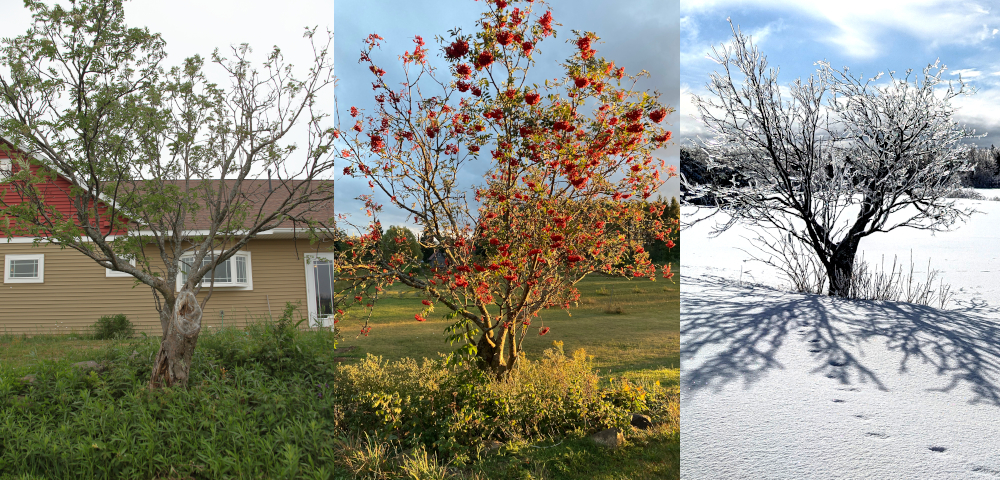Trying to see beauty after 13 years with a diagnosis of ALS
Observing a mountain ash that still flowers through its decay, just as he does

As I fed my husband, Todd, his morning breakfast, a charm of yellow finches caught our attention, flitting to and from a mountain ash outside our dining room window. That old tree has brought many moments of joy that are sweet reprieve from the daily challenges of life with ALS.

Mountain ash in three seasons. (Photos by Kristin Neva)
The tree is now deteriorating, with a rotted trunk and sparse leaves, but every spring it blossoms clusters of white flowers. It doesn’t turn yellow in autumn like a proper mountain ash, but after shedding its dried green leaves, its berries turn bright orange and hold tight for most of our snowy winters. We thrill at the sight in January, when within a few days grosbeaks descend en masse and eat the tree clean.
In the remaining winter months, we watch chickadees snatch sunflower seeds from a copper bird feeder that we hang from one of the branches. Squirrels scheme to get their share, and occasionally our dog, Comet, catches one in the act, sending it to the top of the tree until Comet gets bored or distracted.
On occasion rime covers the branches, and we marvel at the light caught by the ice.

The mountain ash and barn in 1982, on the site where our house now stands. (Photo by Lani Siirtola)
The mountain ash tree has stood in that location for over 70 years now. It had already spent decades next to an old barn when my parents bought their farmhouse 47 years ago. My mom and I picnicked under that tree when I was a child.
The tree remained there for years after the barn blew down, and my dad kept it there when he cleared shrub and hauled away the barn’s wood to make way for our accessible house. We built our home 11 years ago in the spot of the old barn, keeping the tree even as we wondered how long it’d survive.
One side of the trunk was spongy and rotted then, and it’s only deteriorated in the decade that’s followed. In 2020, a large limb on the east side of the tree broke in a windstorm, and my son cut it off. Last year, another major branch on the south side died completely, and our neighbor cut off that section of the tree at the trunk.
Todd suggested once that we cut the tree down and replace it with a birch or maple, but I rejected that idea. The existing tree reminds me that life perseveres, and even in its broken state, the mountain ash radiates a weathered beauty and still produces fruit. That tree may have produced more fruit when it was healthy, but it’s more inspiring to see what it continues to give even in its decayed state.
Similarly, before ALS, my husband was patient, kind, and encouraging, but now in the midst of such a hellish disease, the fact that Todd still remains patient, kind, and encouraging is a marvel. And he’s remained my partner and co-parent of our daughter and son.
This Sunday, June 11, marks the 13-year anniversary of his ALS diagnosis. That’s a long time to live with a disease that keeps taking — from just having a weak arm, to needing a wheelchair, to being completely paralyzed, to needing breathing support nearly 24/7.
Grief accompanied each of those losses. I cry as I think about what we’ve been through — falling, choking, struggling to breathe — and as Todd’s health has deteriorated, we’ve become mostly homebound, making us feel isolated and bored. ALS is a brutal disease.
Thirteen years ago, we didn’t think Todd would survive to see our children into their teen years, because unfortunately most people with ALS only live for two to five years after diagnosis. But he beat the odds, and as hard as it is living with progressive disability, we still have moments of joy. And I’m glad our kids have grown up with an engaged father.
Our mountain ash will eventually die as it increasingly struggles to capture carbon dioxide from fewer and fewer leaves, but this summer we plan to transplant a sapling mountain ash to the foot of that old tree. And as our children continue to mature, I look forward to seeing that small tree grow in the shadow of our old mountain ash.
Note: ALS News Today is strictly a news and information website about the disease. It does not provide medical advice, diagnosis, or treatment. This content is not intended to be a substitute for professional medical advice, diagnosis, or treatment. Always seek the advice of your physician or other qualified health provider with any questions you may have regarding a medical condition. Never disregard professional medical advice or delay in seeking it because of something you have read on this website. The opinions expressed in this column are not those of ALS News Today or its parent company, BioNews, and are intended to spark discussion about issues pertaining to ALS.








Comments
Paul
Thanks for sharing your heartfelt story. I too was diagnosed 13 years ago so I can relate first hand to your experience. All the best on your journey.
Kristin Neva
Paul, thanks for commenting. 13 years for you too--wishing you the best as well.
Gail Albert
Dear Kristin,
I have read your columns since my husband was diagnosed in 2019. They are always poignant and hopeful and keep me focused on seeing the good and positive things. I hope you can help me with a question.
My husband has had difficulty learning to use eye gaze. But he is able to still move his head, so I think he would be able to use a head mouse to navigate his computer. I know you have spoken of Todd using a device like that. I was hoping you could offer some advice regarding the type of technology he uses. I have been researching and there are several different types available. I would be so appreciative of any advice or suggestions you might have.
His speech was the first thing he lost back in 2018 and he lost his ability to type on his speech generating device in late 2021. We would be so grateful for anything you or Todd could offer.
Kind regards,
Gail Albert
Kristin Neva
We made a video about Todd's headmouse on our YouTube channel, ALS411: https://www.youtube.com/watch?v=v2wuJPV3--E Todd first used a foot mouse to click it. Now he clicks it with a sip-n-puff by sucking on a straw. If your husband can still suck water from a straw, then that may be a good option. There are also micro-switch options if he has movement anywhere and a dwell time option. I hope you can find a solution.
Kathleen B
WOW! Thank you Kristin N ❤️. I have been reading your articles since my ALS diagnosis in 2021–and I have saved several. By far, I consider this one the ‘BEST of the best’! We (caregiver husband & self) can share all those up & down events & emotions, even though we’ve just begun this journey and have 3 young adult children. I will make a print of this 6-8-23 item to share with them…it just might help them resolve some of the anger stage of grief they are experiencing at this point. Thanks again for helping others!
Kristin Neva
Thank you for the encouragement! I'm glad to hear our story is helpful.
Ed. T
Thank you for sharing part of your journey with us. My wife of 41 years was diagnosed last month and just as you stated, it has turned our world upside down. Your story is so filled of hope and love, it brings tears to me so, I'm trying to be strong but sometimes find it so difficult. My wife is up by 3am and asleep by 4 or 5pm, which I then hang in my office listing to music and reading to fill the nighttime loneness. I find comfort in reading stories like yours but also fear. God bless my friend.
Kristin Neva
Thank you for the encouraging words. I'm sorry to hear of your wife's diagnosis.